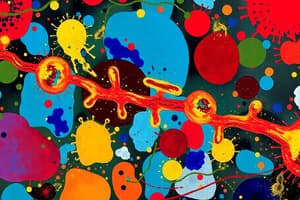Podcast
Questions and Answers
Which of the following statements about nucleotides is true?
Which of the following statements about nucleotides is true?
- Nucleotides contain only nitrogenous bases.
- Nucleotides are composed of a pentose sugar. (correct)
- Nucleotides do not have phosphate groups.
- Nucleotides are only found in RNA.
What forms between the carbon at the 3' position of a nucleotide and the phosphate group at the 5' position of the next nucleotide?
What forms between the carbon at the 3' position of a nucleotide and the phosphate group at the 5' position of the next nucleotide?
Covalent bond
RNA usually consists of a double polynucleotide chain.
RNA usually consists of a double polynucleotide chain.
False (B)
What enzyme untwists the double helix and separates the two DNA strands?
What enzyme untwists the double helix and separates the two DNA strands?
What is the process that repairs damage to a preexisting double helix?
What is the process that repairs damage to a preexisting double helix?
What are the repetitive DNA sequences present at the ends of eukaryotic chromosomes called?
What are the repetitive DNA sequences present at the ends of eukaryotic chromosomes called?
What are chromosomes made of?
What are chromosomes made of?
During interphase, DNA exists as chromatin and is available for gene expression.
During interphase, DNA exists as chromatin and is available for gene expression.
What catalyzes DNA synthesis?
What catalyzes DNA synthesis?
Primers are short sequences that allow the initiation of DNA synthesis.
Primers are short sequences that allow the initiation of DNA synthesis.
Which part of a deoxynucleoside triphosphate (dNTP) molecule provides the energy for DNA synthesis?
Which part of a deoxynucleoside triphosphate (dNTP) molecule provides the energy for DNA synthesis?
Which enzyme creates a primer for DNA polymerase?
Which enzyme creates a primer for DNA polymerase?
Okazaki fragments are formed on the leading strand of DNA in E.coli.
Okazaki fragments are formed on the leading strand of DNA in E.coli.
Flashcards are hidden until you start studying
Study Notes
Polynucleotides
- Formed by covalent bonds between the 3' carbon of one nucleotide and the 5' phosphate group of the next.
RNA
- Typically consists of a single polynucleotide chain, which is crucial for its various functions in the cell.
DNA Structure
- Composed of two polynucleotide chains (strands) oriented in opposite directions.
- Strands are held together by hydrogen bonds between nitrogenous bases.
Nucleotides
- Consist of a pentose sugar, a nitrogenous base, and a phosphate group, which are the building blocks of nucleic acids.
Helicase
- Enzyme that untwists the double helix and separates the two DNA strands, facilitating replication.
Semiconservative Replication
- New double helices consist of one old strand and one newly synthesized strand, ensuring genetic consistency.
DNA Repair
- Nucleotide excision repair addresses DNA damage by removing the damaged section and filling the gap using DNA polymerase and DNA ligase.
Telomeres
- Repetitive DNA sequences found at the ends of eukaryotic chromosomes, composed of multiple copies of short DNA sequences and specific proteins.
Chromosomes
- Made of DNA and proteins, allowing for coiling and packing of long DNA molecules into a compact form.
DNA During Interphase
- Exists as chromatin, which is less coiled and unavailable for gene expression. Parts of chromatin can still be tightly packed.
DNA Synthesis
- Catalyzed by DNA polymerase, which adds nucleotides to synthesize DNA.
Role of Primers
- Short sequences necessary for initiating DNA synthesis; DNA polymerase can only add nucleotides to an existing strand.
Energy for DNA Synthesis
- Potential energy stored in the bonds of phosphate groups in dNTP molecules powers DNA synthesis.
Primase
- RNA polymerase that synthesizes an RNA primer antiparallel to the template DNA strand, enabling DNA polymerase to start synthesis.
Okazaki Fragments
- Formed on the lagging strand during DNA replication in E. coli, created because DNA synthesis is always in the 5' to 3' direction.
Studying That Suits You
Use AI to generate personalized quizzes and flashcards to suit your learning preferences.





